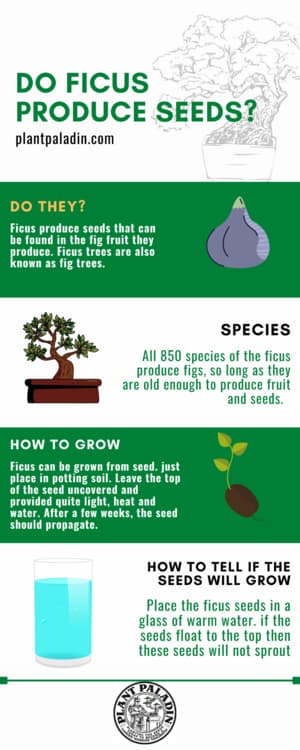This website is supported by its readers. If you click one of my links I may earn a commission. I am also a participant in the Amazon affiliates program and I will also earn a commission from qualified purchases.
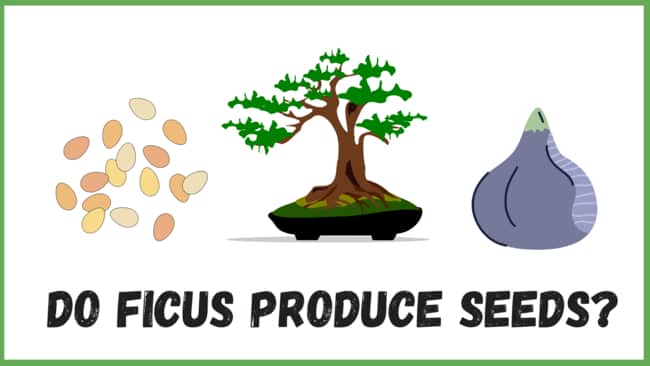
Ficus trees are among one the most popular indoor trees you can opt for, with an estimated 850 sub-species. Not only can Ficus be transformed into incredible bonsai, but they can also be grown from scratch in most environments. So do Ficus produce seeds?
The vast majority of the 850 Ficus tree species produce seeds. Seeds are typically found inside the Fig fruit or in seed pods located across the tree. These seeds can be easily propagated without the need for soil.
So what do Ficus seeds look like? And how can you grow a Ficus tree from seed? Keep reading to find out more!
Just a quick heads up, over the past three years of running Plantpaladin, hundreds of people have asked for product recommendations. As such, You can find my favorite indoor bonsai tree here (link takes you to Bonsaiboy), my favorite outdoor bonsai tree (link takes you to Bonsaiboy), or have a look at all the products I recommend here.
Do Ficus produce seeds?
To get to the bottom of if Ficus produces seeds, I tried growing out my Fig tree, got in touch with my local tropical botanical gardens, and asked 20 Plant Paladin readers who have their Ficus trees the answer to this question.
To summarize:
- Most Ficus species produce seeds.
- These seeds are most commonly located in Fig fruit, to access them, cut the Fig in half when ripe and scoop out the seeds.
- Depending on the species of Ficus, you can have a lot of seeds, most Ficus produce Figs that contain upwards of 750 seeds.
- Ficus seeds can be propagated easily and can grow without covering in topsoil if need be.
- Ginseng Ficus seeds work best if you want to grow a bonsai tree and Ficus Elastica seeds work best if you want to grow an easy to care for Ficus bonsai.
Where to find Ficus seeds?
Ficus seeds are most commonly found in the Fig fruit that they produce.
To access them, ensure that your Fig is ripe.
This tends to be near the end of summer so late august.
Then get a sharp knife and cut the Figstraight down the middle.
Using a teaspoon, scoop out the seeds along with some of the flesh.
Then try to separate as many of the seeds from the flesh as possible.
Keep them in warm water for about 2 to 3 days.
The seeds will then be ready to be planted.
Do all Ficus produce seeds?
All Ficus trees that have been fertilized will produce seeds that can grow into their Ficus trees.
That being said, Ficus trees are unique in the sense that they have a symbiotic relationship with Fig wasps to thrive.
The general gist of it is a Fig wasp will enter the Figs of a ficus tree and having pollinated other Figs will pollinate the seeds located inside the Figs.
As a trade-off, the Figs will become home to the Fig wasps’ offspring which will eat the surrounding fruit to grow.
One of the major reasons why your Ficus may not be producing seeds is that its seeds might not have been fertilized by a Fig wasp.
Why is my Fig tree not producing fruit?
If your Fig/Ficus tree is not producing fruit, the most common reason is that your tree is too young. Ficus trees need to reach maturity before they can start producing new Figs and fruit. Most Ficus trees will produce fruit after 3 years.
Can you grow a Ficus from a seed?
Ficus trees of all species can be grown from seeds found inside Fig fruit. To do so, remove the seeds from the Fig, remove any unfertilized seeds and place them in potting soil in warm conditions. Keep moist and your seeds will bloom.
So now we know that Ficus trees produce seeds that can be found in Figs, what is the exact step-by-step process of growing a Ficus from a seed?
Let’s explore this in more detail
Get the seeds from the Figs
First up we need to get the seeds from the Fig plant.
We touched upon this earlier on but first, ensure that it is the right time of year – Figs tend to ripen at the end of the summer.
Then using a sharp knife cut the Fig down the middle and use a spoon to scoop out some of the seeds from your Fig.
Determine which seeds are fertile
Next up rise off any of the excess fig mulch that surrounds the seeds until you have clean seeds.
Then place your seeds in a small glass of water.
This can be either warm or cold, tap water or rainwater.
Keep the seeds in the cup for a few days until some seeds drop to the bottom.
The seeds that have been fertilized by Fig wasps will drop to the bottom of the cup whilst the seeds that are sterile or have not been fertilized will float – you can discard these seeds.
Gather your potting soil
Next up, gather your potting soil.
The type of soil you will use will vary depending on the type of Ficus and tree you are growing.
For example, if you are using ginseng Ficus seeds to be used in bonsai, then consider using an inorganic soil mix of akadama, volcanic ash rock, and other grit to grow your Ficus bonsai.
Alternately, if you are growing a FicusEelastica – also known as the rubber Fig other soil mixes will be needed.
Luckily Ficus is a relatively easy growing tree and can survive in pretty much any soil condition, for most of you reading this, a peat seed soil mix or cactus soil will work best.
Gather your pot
Next up, gather the pot that you will place your seed in.
For Ficus seeds, I like to use small yogurt pots as they are a perfect size.
Adding a few pencil-sized drainage holes however will be essential.
Once you have added your drainage pot fill up with the potting soil and make a fingertip-sized indentation.
Place your seed
Next up gently place your seed, ideally facing down in the soil.
Do not cover your seed with topsoil.
As Ficus are tropical plants they require a lot of sunlight and heat to propagate.
Covering them with topsoil then can potentially stunt their growth.
Move your Ficus into position and maintain
Once you have plated your Ficus, ensure you give it correct aftercare.
Ensure the topsoil stays moist by checking for dry topsoil.
If dry to touch, spritz/ water the soil.
Ensure the temperature for your Ficus does not fall below 77 degrees Fahrenheit or 25 degrees celsius.
If you live in a colder climate then consider moving your Ficus either indoors or growing your tree in a greenhouse.
Using artificial grow light can also help.
Repot your plant
Once your Ficus starts to generate small leaves, it is time to repot your Ficus to a bigger pot with more drainage holes.
Consider repotting your tree once per year as a rule of thumb to ensure the tree roots have enough space to grow.
Are Ficus seeds toxic?
Ficus/Fig seeds can be hard to digest and so should be removed before consumption. Fig seeds also contain Ficin which can be toxic to dogs, causing drooling, diarrhea, and vomiting.
How fast do Ficus seeds grow into trees?
It can take 5 years for Ficus to mature into trees from seed. Most Ficus tree species will take a few weeks to see green shoots and roots growing from your soil. After this, expect about one to two feet (12 to 24 inches) foot of growth in your first year.
This will vary greatly however from species to species.
Ficus trees used for bonsai such as Ginseng Ficus will grow at a much slower growth rate, averaging between 2 to 5 inches of growth per year.
This is because the miniaturization of the tree will cause the seeds to take longer to mature.
Does unfertilized Ficus produce seeds?
Ficus trees that have not been fertilized by Fig wasps will produce seeds, however, these seeds will be unfertilized and not grow into trees of their own.
How do you get Ficus seeds?
Ficus seeds can either be taken from existing Figs that are ripe by cutting them open and removing the seeds from the Fig fruit that Ficus produces. Alternatively, Ficus seeds are widely available online and in stores.
Can you buy Fig seeds?
Ficus seeds can be purchased in stores from reputable retailers as well as online. Opt to purchase seeds this way to get Ficus species that are harder to find and do not grow naturally in their locations.
What do Ficus seeds look like?
Ficus seeds are tiny white/brown seeds that are less than 1mm in diameter. They often resemble the seeds that can be found in tomatoes. These seeds however are typically hard to touch. On average there are about 750 small seeds found inside Figs.
The images below should help give an idea of what ficus seeds look like:
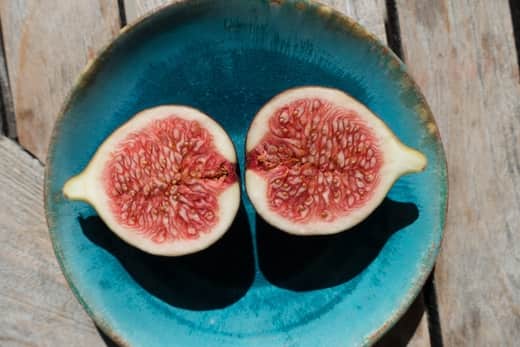
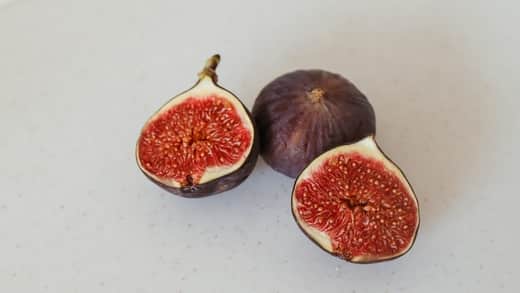

Do you have to prepare Ficus seeds before planting them?
Most Ficus seeds will not need excessive preparation before planting them.
Instead, all you will need to do is remove the unfertilized seeds from the fertilized seeds by using water.
Generally, as Ficus as tropical species, they do not typically need to go through the scarification or stratification process.
That being said, if you are growing a Ficus that is not native to where you live, or are growing Ficus seeds outside season then you may need to stratify your seeds.
To do this, fill up a plastic box or bag with a damp paper towel or moss of some kind – I like to use sphagnum moss.
Gently place your seed in the bag with the moss or damp paper towel and keep it in a refrigerator.
Check-in on your seeds for a week or so and your seeds will have started to sprout leaves.
You can then follow the above steps to plant your seeds.
How many years does it take for Ficus to start producing seeds?
Ficus trees will start to produce Fig fruit and seeds when they start to reach maturity, which is typically after about 3 years of growth. This can take longer if you are growing a Ficus such as Ginseng Ficus for bonsai, which can take upwards of five years.
Can you grow a Ficus without seed?
Ficus can be grown without seed by cloning the tree with a cutting. Simply cut off a branch of an existing Ficus. Peel the bottom inch of the branch back until the inner wood is exposed. Place in water and leave for a few weeks.
Roots will then start to form on the cutting which you can then plant.
What are Ficus seeds?
Ficus seeds are the seeds that are found inside the Fig fruit Ficus produces. These seeds can be grown into Ficus trees if planted correctly. These seeds tend to ripen inside Figs in August.
How easy is it to grow a Ficus from a seed?
Finally, I didn’t just want to give my opinion but ask some of my readers how easy it was to grow a Ficus from a seed.
As such, I did a quick survey of 20 of my readers who have grown Ficus bonsai and asked them how easy it is to grow Ficus from a seed.
Here were the results:
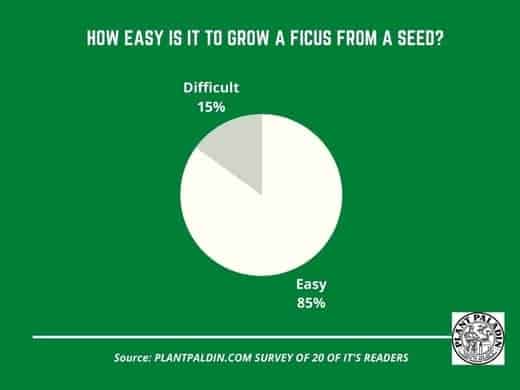
My top picks for the gear you will need!
So like I mentioned earlier, over the past three years of running PlantPaladin, hundreds of people have asked me for my recommendations on the best bonsai gear on the market.
Having spent thousands of dollars on bonsai items these past few years and tested at least 100 bonsai-specific products, I’ve listed my favorite products below – All of which I highly recommend and think you can get great value.
They can purchase directly by clicking the link to take them to Amazon.
Bonsai Tool Set: One of the significant challenges I’ve had is finding a toolset that was not only durable but didn’t break the bank. SOLIGT has recently developed a fantastic bonsai tool set that covers all the tools you need to trim, prune, and repot your trees. – You can grab it here.
Complete Bonsai Set: Many of you will want to grow your bonsai trees entirely from scratch, but finding the varicose seeds, pots, and other items in one place can be challenging. Leaves and Sole then have created a complete bonsai set that I’ve personally used that ticks all the boxes. You can grab it here.
Bonsai wire: The number of times I’ve run out of wire for my bonsai or purchased cheap bonsai wire that doesn’t do the job is embarrassing for me to admit. After a lot of trial and error, I found that using Hotop’s aluminum bonsai wire is one of the best options on the market. This can easily be used for both indoor and outdoor bonsai. You can grab it here.
This post was written by Fehed Nicass who has been passionate about bonsai for over 3 years. He currently resides in the UK and works in sales.

